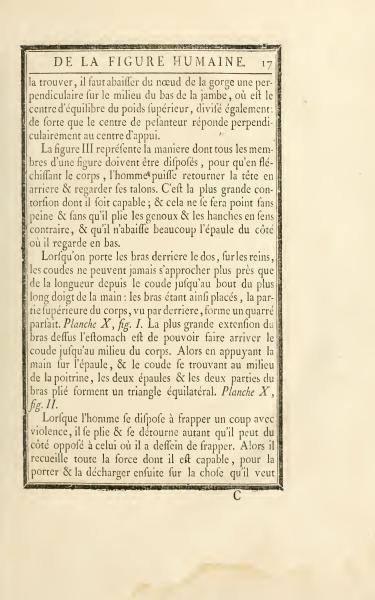ON THE HUMAN FIGURE
...to find it, one must lower from the knot of the throat a perpendicular to the middle of the lower leg, where the center of balance of the upper weight is equally divided: so that the center of gravity responds perpendicularly to the point of support.
Figure III illustrates the way all the limbs of a figure must be arranged so that when the body bends, the person can turn their head backward and look at their heels. This is the greatest contortion they are capable of; and it will not be done without difficulty and without bending the knees and hips in the opposite direction, and lowering the shoulder on the side they are looking down.
When one places their arms behind their back, on the loins, the elbows can never get closer than the length from the elbow to the tip of the longest finger: when the arms are thus placed, the upper part of the body, seen from behind, forms a perfect square. Plate X, fig. I. The greatest extension of the arm over the stomach is to be able to make the elbow reach the middle of the body. Then, by resting the hand on the shoulder, and the elbow being in the middle of the chest, both shoulders and both parts of the folded arm form an equilateral triangle. Plate X, fig. II.
When a person prepares to strike a blow with force, they bend and turn as much as possible away from the side they intend to strike. Then they gather all the strength they are capable of, to deliver it and then release it onto the object they intend to hit.
The text explains how the human body must be arranged for balance and flexibility. It describes how to achieve the greatest contortion, and how to position the arms and elbows for a perfect square shape, as well as an equilateral triangle when positioned differently. Additionally, it discusses how to gather strength for a forceful action by bending and turning the body appropriately.
